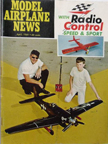April, 1969

Model Airplane News Cover for April, 1969
Boeing XF8B-1
Click to Enlarge
Here is what the blurb about the cover has to say:
"... Dick Graham and his young son Doug pose proudly with Pop's beautiful Boeing XF8B-1 WW II experimental fighter. Doug fle this plane to a fine 9th place in the scale competition at the 1968 National championships. The photo is by Claude McCullough..."
About the Model
From all appearances, this is a fantastic model -- contra-rotating propellors are very hard to do. The nice thing about this arrangement is that the torque associated with each prop balances out -- if it is done correctly. Many modelers face problems with skewing to the riight resulting from the propellor's inertia. Since it is very hard to trim a model, builders often just offset the engine by a degree or two to compensate for toruqe.. It is really hard to tell the difference between Mr. Graham's model and the original (see below)
Here is a video of a 21st Century radio controlled model of the XF8B-1:
See our profile of modeler/photographer Claude McCulloug in the July, 1968 issue of MAN.
About the Full Size Airplane
The Boeing XF8B was developed by Boeing during World War II to provide the Navy a long-range shipboard fighter aircraft. The XF8B was intended for operation against the Japanese home islands from aircraft carriers outside the range of Japanese land-based aircraft. Designed for various roles including interceptor, long-range escort fighter, dive-bomber and torpedo bomber, the final design embodied a number of innovative features in order to accomplish the various roles. It never entered series production.


Boeing XF8B-1 "Five-in-One"
Click to Enlarge
The XF8B-1 was the largest single-seat, single-engine fighter developed during WWII. It was touted as the "five-in-one fighter" (fighter, interceptor, dive bomber, torpedo bomber, or level bomber). It was powered by a single 3,000 hp 28-cylinder radial engine, driving two three-bladed contra-rotating propellors. The large wings featured outer sections which could fold vertically, while the fuselage incorporated an internal bomb bay and large fuel tanks; more fuel could be carried externally. The proposed armament included six 0.50 inch machine guns or six 20 mm wing-mounted cannons, and a 6,400 lb bomb load or two 2,000 lb torpedoes. The final configuration was a large but streamlined design, featuring a bubble canopy, sturdy main undercarriage that folded into the wings, and topped by a variation on the B-29 vertical tail. The contract for three prototypes was awarded in 1943, although only one was completed before the war ended. It first flew in November 1944.
Here is another video of an RC model of the plane. It does make a good flyer!

Click to go back and select another cover.
Counter for the Entire Site (not just this page..)
Home | About Lindy | Last Week's Reviews | Upcoming Events | 1940s Collecibles
The Guide - Establishments - Travel - Accessories
Music | Links | Photo Gallery | Extras | Contact